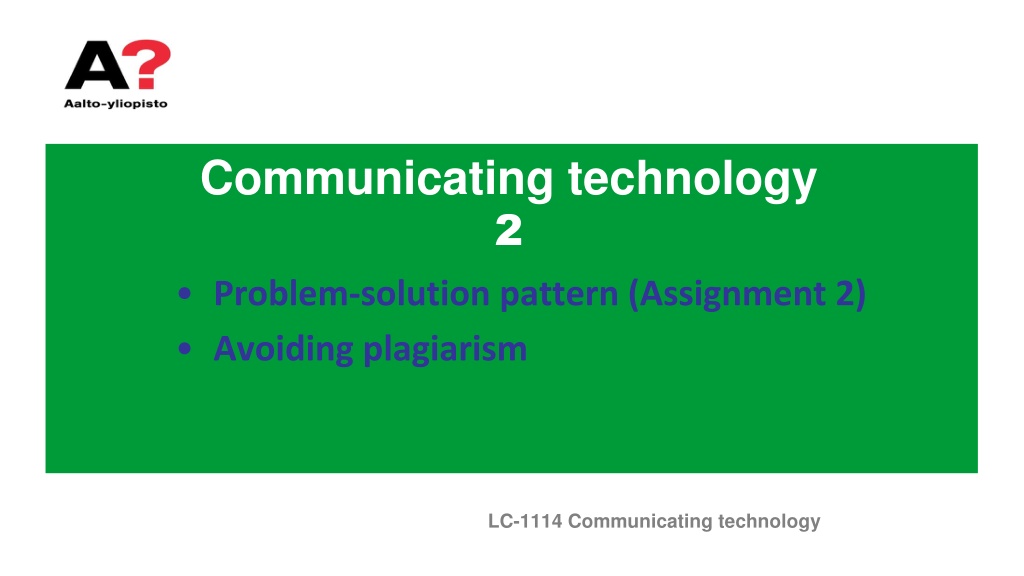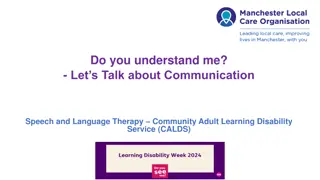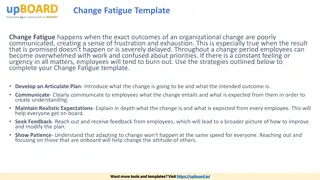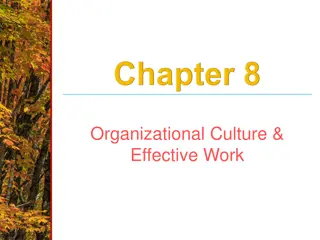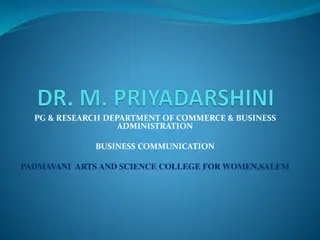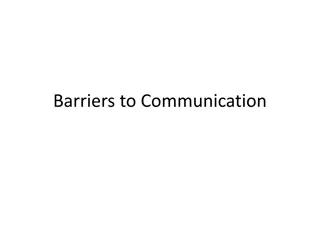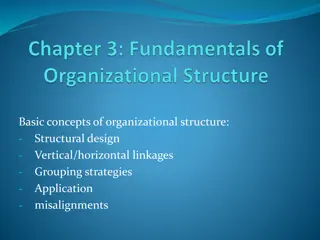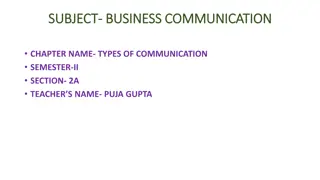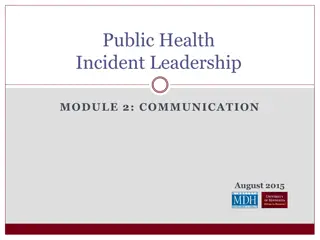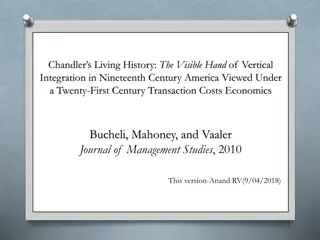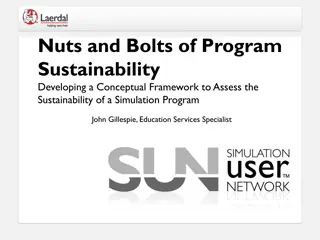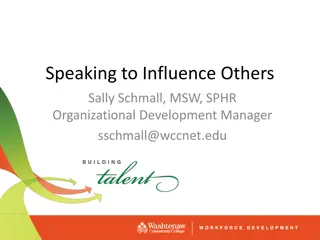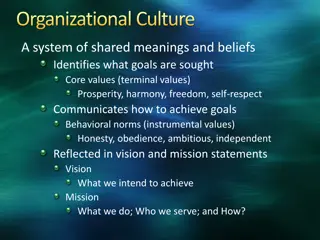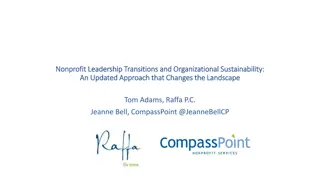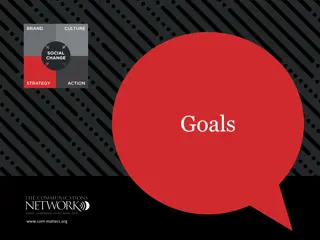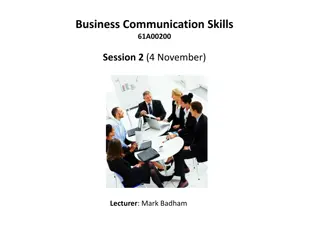Effective Communication Strategies in Addressing Organizational Challenges
Effective communication involves tailoring your message to your audience, purpose, and form. Using the problem-solution pattern can help in organizing technical academic writing. This pattern consists of four moves: Situation, Problem, Solution, and Evaluation, each crucial in addressing the current situation, identifying the problem, proposing solutions, and evaluating their effectiveness.
Download Presentation

Please find below an Image/Link to download the presentation.
The content on the website is provided AS IS for your information and personal use only. It may not be sold, licensed, or shared on other websites without obtaining consent from the author. Download presentation by click this link. If you encounter any issues during the download, it is possible that the publisher has removed the file from their server.
E N D
Presentation Transcript
Communicating technology 2 Problem-solution pattern (Assignment 2) Avoiding plagiarism LC-1114 Communicating technology
The The problem problem- -solution of of organisation organisation solution pattern pattern Introduction paragraph (A2)
Successful communication Product of three considerations: 1. Audience 2. Purpose 3. Form What form will best accomplish your purpose with this particular audience? Organization Style 3
3 Form: organisation 3 Form: organisation The most important pattern of organization in technical academic writing is the problem-solution pattern Four moves: 1. Situation What is relevant or important about the topic? 2. Problem What is wrong with the current situation? What is needed or lacking? 3. Solution What solutions past and current have been tried? 4. Evaluation Is this a good solution? 4
Importance? Relevance? What is the current situation? Situation Why is the topic important for this reader? What is wrong with the current situation? Causes? Consequences? Past problem? Criteria for solving? Problem What is needed / lacking? What are its features? How does it work? What is your solution? Solution Is this a good solution? How effective is it? Meet criteria? Why? Evaluation
Situation Importance, relevance major, important, popular, common, and many Causes, consequences, past solutions, contrast (However, despite, although, but), negative(limited, few, little, no, not, none), synonyms (danger, drawback, disadvantage, weakness, need, shortcoming, obstacle). Problem Features? How does it work? nounssolution, answer, approach, strategy,improvement verbssolve, addressa problem, work out, develop causativeconnectorstherefore, as a result, thus Solution How effective? Meet the criteria? nounsbenefit, advantage verbsprovide, offer, enable, allow adjectiveseffective, efficient, reliable, safe, useful Evaluation
Task 2-1: E-reader recommendation 1. Read the three versions of an introduction to a recommendation report. 2. How do they differ? 3. Which version do you prefer? Why? 7
Task 2-1 Introduction A 1The threat of global warming has forced consumers to find green alternatives to many of the everyday objects that we use. 2One important object that is widely used for both entertainment and educational purposes is the book. 3However, to feed our need for information and knowledge, the book and newspaper industries require the harvest of 125 million trees each year and emit over 40 million metric tons of CO2 annually, equivalent to the annual CO2 emissions of 7.3 million cars. 4Moreover, considering the conversion into paper, printing and distribution of these printed media, one can easily understand why books have one of the highest per-unit carbon footprints. 5These adverse environmental effects can be avoided by replacing . by replacing . by replacing printed media with digital forms. 1The threat of global warming has forced consumers to find green alternatives to many of the everyday objects that we use. 2One important object that is widely used for both entertainment and educational purposes is the book. 3However, to feed our need for information and knowledge, the book and newspaper industries require the harvest of 125 million trees each year and emit over 40 million metric tons of CO2 annually, equivalent to the annual CO2 emissions of 7.3 million cars. 4Moreover, considering the conversion into paper, printing and distribution of these printed media, one can easily understand why books have one of the highest per-unit carbon footprints. 5These adverse environmental effects can be avoided 5These adverse environmental effects can be avoided 1The threat of global warming has forced consumers to find green alternatives to many of the everyday objects that we use. 2One important object that is widely used for both entertainment and educational purposes is the book. 3However, to feed our need for information and knowledge, the book and newspaper industries require the harvest of 125 million trees each year and emit over 40 million metric tons of CO2 annually, equivalent to the annual CO2 emissions of 7.3 million cars. 4Moreover, considering the conversion into paper, printing and distribution of these printed media, one can easily understand why books have one of the highest per-unit carbon footprints. 8
Task 2-1 Introduction A 5These adverse environmental effects can be avoided by replacing printed media with digital forms. 6Electronic books can be downloaded from the Internet, and then read using special devices, known as e-readers. 7An e-reader allows readers to store many books at once, and is lighter and more portable than the traditional book. 8E-readers are not only being used by the general public but also by specific groups of people for their own special purposes, and the available banks of digital texts are constantly growing. 9These specific groups include college and high school students, mobile professionals, and people with vision problems. 10Therefore this report recommends adopting an e-reader for use by students and staff at the South Tapiola High School. students and staff at the South Tapiola High School. students and staff at the South Tapiola High School. 5These adverse environmental effects can be avoided by replacing printed media with digital forms. 6Electronic books can be downloaded from the Internet, and then read using special devices, known as e-readers. 7An e-reader allows readers to store many books at once, and is lighter and more portable than the traditional book. 8E-readers are not only being used by the general public but also by specific groups of people for their own special purposes, and the available banks of digital texts are constantly growing. 9These specific groups include college and high school students, mobile professionals, and people with vision problems. 10Therefore, this report recommends adopting an e-reader for use by recommends adopting an e-reader for use by 5These adverse environmental effects can be avoided by replacing printed media with digital forms. 6Electronic books can be downloaded from the Internet, and then read using special devices, known as e-readers. 7An e-reader allows readers to store many books at once, and is lighter and more portable than the traditional book. 8E-readers are not only being used by the general public but also by specific groups of people for their own special purposes, and the available banks of digital texts are constantly growing. 9These specific groups include college and high school students, mobile professionals, and people with vision problems. 10 Therefore, this report 9
Task 2-1 Introduction B 1Books and other written media, such newspapers and magazines, havebecome an important part of our social and intellectual life in modern society. 2Indeed, without written media, making informed choices and educating each successive generation would become difficult tasks. 3However, producing these media requires the harvest of 125 million trees each year and emits over 40 million metric tons of CO2 annually, equivalent to the annual CO2 emissions of 7.3 million cars. 4Moreover, it has been estimated that the special storage requirements for books can account for a further 5 million tons of CO2 annually. 5One solution to this problem is to replace printed media with digital forms that can be 1Books and other written media, such newspapers and magazines, have become an important part of our social and intellectual life in modern society. 2Indeed, without written media, making informed choices and educating each successive generation would become difficult tasks. 3However, producing these media requires the harvest of 125 million trees each year and emits over 40 million metric tons of CO2 annually, equivalent to the annual CO2 emissions of 7.3 million cars. 4Moreover, it has been estimated that the special storage requirements for books can account for a further 5 million tons of CO2 annually. 5One solution to this problem is to replace printed media with digital forms that can be stored and read in e-readers . 6E-readers allow the reader and read in e-readers . 6E-readers allow the reader reader 1Books and other written media, such newspapers and magazines, havebecome an important part of our social and intellectual life in modern society. 2Indeed, without written media, making informed choices and educating each successive generation would become difficult tasks. 3However, producing these media requires the harvest of 125 million trees each year and emits over 40 million metric tons of CO2 annually, equivalent to the annual CO2 emissions of 7.3 million cars. 4Moreover, it has been estimated that the special storage requirements for books can account for a further 5 million tons of CO2 annually. 5One solution to this problem is to replace printed media with digital forms that can be stored stored and read in e-readers . 6E-readers allow the 10
Task 2-1 Introduction B to store many books at once, and are lighter and more portable than traditional books. 7E-readers can not only be used by the general public but also by other groups of people for their own specific purposes, including college and high school students, mobile professionals, and people with vision problems. 8South Tapiola High School has received funding from government and private sources to sponsor a pilot project studying the suitability of using e-readers as an integral component of its educational strategy. to store many books at once, and are lighter and more portable than traditional books. 7E-readers can not only be used by the general public but also by other groups of people for their own specific purposes, including college and high school students, mobile professionals, and people with vision problems. 8South Tapiola High School has received funding from government and private sources to sponsor a pilot project studying the suitability of using e-readers as an integral component of its educational strategy. ?? 11
Task 2-1 Introduction C 1Today, studying at the secondary level requires a growing number of books. 2This has not only increased the costs of education but requires other means for transporting and storage of these media on school premises, such as school lockers and knapsacks. 3E-readers could ease these problems by providing students with a single, portable, light-weight location for storing and reading their books, homework and assignments. 4Unlike conventional textbooks, e-readers allow students to search through textbooks quickly for specific information, and many allow the 1Today, studying at the secondary level requires a growing number of books. 2This has not only increased the costs of education but requires other means for transporting and storage of these media on school premises, such as school lockers and knapsacks. 3E-readers could ease these problems by providing students with a single, portable, light-weight location for storing and reading their books, homework and assignments. 4Unlike conventional textbooks, e-readers allow students to search through textbooks quickly for specific information, and many allow the student to highlight important text, to mark their last location in the book, and more importantly to location in the book, and more importantly to location in the book, and more importantly to 1Today, studying at the secondary level requires a growing number of books. 2This has not only increased the costs of education but requires other means for transporting and storage of these media on school premises, such as school lockers and knapsacks. 3E-readers could ease these problems by providing students with a single, portable, light-weight location for storing and reading their books, homework and assignments. 4Unlike conventional textbooks, e-readers allow students to search through textbooks quickly for specific information, and many allow the student to highlight important text, to mark their last student to highlight important text, to mark their last 12
Task 2-1 Introduction C determine the meaning of new vocabulary by right- clicking on a word for a definition or translation. 5E-readers would also provide a central location for storage of all the student s textbooks and assignments. 6To determine the effectiveness of e- readers in educational settings, the South Tapiola High School has decided to conduct a feasibility study before making any decision to invest in e-readers. 7This report compares the benefits and drawbacks of implementing this new technology in Finnish determine the meaning of new vocabulary by right- clicking on a word for a definition or translation. 5E-readers would also provide a central location for storage of all the student s textbooks and assignments. 6To determine the effectiveness of e- readers in educational settings, the South Tapiola High School has decided to conduct a feasibility study before making any decision to invest in e-readers. 7 This report compares the benefits and drawbacks of implementing this new technology in Finnish secondary schools. secondary schools. . Pattern of organization implied: comparison-contrast. Your assignment: extended definition! Purpose: recommend 13
Task 2-2 Alternatives to incandescent lightbulbs 1. Read the following text on alternatives to incandescent lightbulbs. 2. Indicate which sentences discuss a) Situation b) Problem c) Solution d) Evaluation 14
Task 2-2 Alternativesto incandenscent light bulbs 1The incandescent light bulb has served man well for over 100 years. 2The traditional incandescent light bulb is inexpensive and produces good lighting. 3However, because incandescent bulbs produce light by heating a solid material, tungsten, well over 90% of the energy consumed is wasted as heat, resulting in low LPW (lumens per watt) 1The incandescent light bulb has served man well for over 100 years. 2The traditional incandescent light bulb is inexpensive and produces good lighting. 3However, because incandescent bulbs produce light by heating a solid material, tungsten, well over 90% of the energy consumed is wasted as heat, resulting in low LPW (lumens per watt) performance. performance. Situation 1-2 15
Task 2-2 Alternativesto incandenscent light bulbs 1The incandescent light bulb has served man well for over 100 years. 2The traditional incandescent light bulb is inexpensive and produces good lighting. 3However, because incandescent bulbs produce light by heating a solid material, tungsten, well over 90% of the energy consumed is wasted as heat, resulting in low LPW (lumens per watt) performance. Problem 3 16
Task 2-2 Alternativesto incandenscent light bulbs 4 4To reduce waste of energy, the EUhaspromotedthe compact fluorescent lamp (CFL) as analternativeto the incandescent light bulb.5CFLs offer a many advantages over the traditional bulb. 6CFLs have a lifespan between 8 and 15 times longer than that of incandescents. 7CFLs use between one-fifth and one-third less power than incandescent lamps. 8Furthermore, a typical CFL is 17-21% more efficient at converting electric power to radiant power.9However, CFLs take a longer time to achieve full brightness, and even longer at very cold temperatures. 10CFLs also pose a hazard to our environment because they contain small amounts of mercury as vapor inside the glass tubing. 11Moreover, standard 4To reduce waste of energy, the EU has promoted the compact fluorescent lamp (CFL) as an alternative to the incandescent light bulb. 5CFLs offer a many advantages over the traditional bulb. 6CFLs have a lifespan between 8 and 15 times longer than that of incandescents. 7CFLs use between one- fifth and one-third less power than incandescent lamps. 8Furthermore, a typical CFL is 17-21% more efficient at converting electric power to radiant power. 9However, CFLs take a longer time to achieve full brightness, and even longer at very cold temperatures. 10CFLs also pose a hazard to our environment because they contain small amounts of mercury as vapor inside the glass tubing. 11Moreover, standard compact fluorescents fail to operate at temperatures lower than -15 C, and CFLs become dimmer over their lifetime, eventually emitting only 60% of their original light. their lifetime, eventually emitting only 60% of their original light. CFLs become dimmer over their lifetime, eventually emitting only 60% of their original light. 4To reduce waste of energy, the EU has promoted the compact fluorescent lamp (CFL) as an alternative to the incandescent light bulb. 5CFLs offer a many advantages over the traditional bulb. 6CFLs have a lifespan between 8 and 15 times longer than that of incandescents. 7CFLs use between one- fifth and one-third less power than incandescent lamps. 8Furthermore, a typical CFL is 17-21% more efficient at converting electric power to radiant power. 9However, CFLs take a longer time to achieve full brightness, and even longer at very cold temperatures. 10CFLs also pose a hazard to our environment because they contain small amounts of mercury as vapor inside the glass tubing. 11Moreover, standard compact fluorescents fail to operate at temperatures lower than -15 C, and CFLs become dimmer over compact fluorescents fail to operate at temperatures lower than -15 C, and Solution 1 4 17
Task 2-2 Alternativesto incandenscent light bulbs 4To reduce waste of energy, the EU has promoted the compact fluorescent lamp (CFL) as an alternative to the incandescent light bulb. 5 5CFLs offer a many advantages over the traditional bulb.6CFLs have a lifespan between 8 and 15 times longer than that of incandescents. 7CFLs use between one-fifth and one-third less power than incandescent lamps.8Furthermore, a typical CFL is 17-21% more efficient at converting electric power to radiant power.9However, CFLs take a longer time to achieve full brightness, and even longer at very cold temperatures. 10CFLs also pose a hazard to our environment because they contain small amounts of mercury as vapor inside the glass tubing. 11Moreover, standard compact fluorescents fail to operate at temperatures 4To reduce waste of energy, the EU has promoted the compact fluorescent lamp (CFL) as an alternative to the incandescent light bulb. 5CFLs offer a many advantages over the traditional bulb. 6CFLs have a lifespan between 8 and 15 times longer than that of incandescents. 7CFLs use between one- fifth and one-third less power than incandescent lamps. 8Furthermore, a typical CFL is 17-21% more efficient at converting electric power to radiant power. 9However, CFLs take a longer time to achieve full brightness, and even longer at very cold temperatures. 10CFLs also pose a hazard to our environment because they contain small amounts of mercury as vapor inside the glass tubing. 11Moreover, standard compact fluorescents fail to operate at temperatures lower than -15 C, and CFLs become dimmer over their lifetime, eventually emitting only 60% of their original light. their lifetime, eventually emitting only 60% of their original light. lower than -15 C, and CFLs become dimmer over their lifetime, eventually emitting only 60% of their original light. 4To reduce waste of energy, the EU has promoted the compact fluorescent lamp (CFL) as an alternative to the incandescent light bulb. 5CFLs offer a many advantages over the traditional bulb. 6CFLs have a lifespan between 8 and 15 times longer than that of incandescents. 7CFLs use between one- fifth and one-third less power than incandescent lamps. 8Furthermore, a typical CFL is 17-21% more efficient at converting electric power to radiant power. 9However, CFLs take a longer time to achieve full brightness, and even longer at very cold temperatures. 10CFLs also pose a hazard to our environment because they contain small amounts of mercury as vapor inside the glass tubing. 11Moreover, standard compact fluorescents fail to operate at temperatures lower than -15 C, and CFLs become dimmer over 5-8 Positive Evaluation 18
Task 2-2 Alternativesto incandenscent light bulbs 4To reduce waste of energy, the EU has promoted the compact fluorescent lamp (CFL) as an alternative to the incandescent light bulb. 5CFLs offer a many advantages over the traditional bulb. 6CFLs have a lifespan between 8 and 15 times longer than that of incandescents.7CFLs use between one-fifth and one-third less power than incandescent lamps. 8Furthermore, a typical CFL is 17-21% more efficient at converting electric power to radiant power.9However, CFLs take a longer time to achieve full brightness, and even longer at very cold temperatures. 10CFLs also pose a hazard to our environment because they contain small amounts of mercury as vapor inside the glass tubing. 11Moreover, standard compact fluorescents fail to operate at temperatures lower than -15 C, 4To reduce waste of energy, the EU has promoted the compact fluorescent lamp (CFL) as an alternative to the incandescent light bulb. 5CFLs offer a many advantages over the traditional bulb. 6CFLs have a lifespan between 8 and 15 times longer than that of incandescents. 7CFLs use between one- fifth and one-third less power than incandescent lamps. 8Furthermore, a typical CFL is 17-21% more efficient at converting electric power to radiant power. 9However, CFLs take a longer time to achieve full brightness, and even longer at very cold temperatures. 10CFLs also pose a hazard to our environment because they contain small amounts of mercury as vapor inside the glass tubing. 11Moreover, standard compact fluorescents fail to operate at temperatures lower than -15 C, and CFLs become dimmer over their lifetime, eventually emitting only 60% of their original light. and CFLs become dimmer over their lifetime, eventually emitting only 60% of their original light. Negative evaluation 9-11 19
Task 2-2 Alternativesto incandenscent light bulbs 12Recently, the light-emitting diode (LED) has been proposed as a more efficient alternative to the incandescent and fluorescent lamps. 13A light-emitting diode (LED) is a semiconductor device that emits visible light when an electric current passes through it through a process of electroluminescence.14The LED is very compact, robust and features a very long lifetime. 15Compared to these two previous technologies, LEDs are considerably more energy efficient, contain no hazardous substances, operate under a larger range of temperatures and 12Recently, the light-emitting diode (LED) has been proposed as a more efficient alternative to the incandescent and fluorescent lamps. 13A light- emitting diode (LED) is a semiconductor device that emits visible light when an electric current passes through it through a process of electroluminescence. 14The LED is very compact, robust and features a very long lifetime. 15Compared to these two previous technologies, LEDs are considerably more energy efficient, contain no hazardous substances, operate under a larger range of temperatures and conditions, and start up immediately. conditions, and start up immediately. Solution 2 12-13 20
Task 2-2 Alternativesto incandescent light bulbs 12Recently, the light-emitting diode (LED) has been proposed as a more efficient alternative to the incandescent and fluorescent lamps.13A light- emitting diode (LED) is a semiconductor device that emits visible light when an electric current passes through it through a process of electroluminescence.14The LED is very compact, robust and features a very long lifetime. 15Compared to these two previous technologies, LEDs are considerably more energy efficient, contain no hazardous substances, operate under a larger range of temperatures and conditions, and start up contain no hazardous substances, operate under a larger range 12Recently, the light-emitting diode (LED) has been proposed as a more efficient alternative to the incandescent and fluorescent lamps.13A light- emitting diode (LED) is a semiconductor device that emits visible light when an electric current passes through it through a process of electroluminescence.14The LED is very compact, robust and features avery long lifetime. 15Compared to these two previous technologies, LEDs are considerably more energy efficient, 12Recently, the light-emitting diode (LED) has been proposed as a more efficient alternative to the incandescent and fluorescent lamps. 13A light- emitting diode (LED) is a semiconductor device that emits visible light when an electric current passes through it through a process of electroluminescence. 14The LED is very compact, robust and features a very long lifetime. 15Compared to these two previous technologies, LEDs are considerably more energy efficient, contain no hazardous substances, operate under a larger range of temperatures and conditions, and start up immediately. immediately. of temperatures and conditions, and start up immediately. Positive Evaluation 14-15 21
Introduction paragraph: problem-solution Situation = wider context and relevance - Describe the general importance/relevance of topic - State current context (client description, current client practices. Name the client!) 1. Problem = weakness/problem in or a need arising from your client s current practices. - Explain what is currently lacking/needed/unsatisfactory ( However, ) 2. 3. Solution - Name the proposed solution to overcome the problem. Evaluation - Briefly state the main advantage of this solution to justify the recommendation. 4. Include appropriate in-text citations and, the end of your text, a list of references to sources you have used to find the information.
HOMEWORK: ASSIGNMENT 2 Report introduction Pattern of organisation Problem-solution Topic ONE of the problems/needs and its solution from the pre-course Audience Decision makers,educated butnon-expert Length 150- 200 words Instructions in Mycourses! This text will become the introductory paragraph of the recommendation report (your final written assignment) Use the problem-solution template in the task instructions to motivate your recommendation effectively and to orient your reader clearly to its relevance. Provide references to your sources. Deadline have your Overlook shareable link ready for class !
Avoiding plagiarism but why and how?
What is plagiarism? /pledrz()m/ Plagiarism is the copying or paraphrasing of other people s work or ideas without full acknowledgement. (http://www.ox.ac.uk/students/academic/guidance/skills) Synonyms: Piracy & theft, borrowing
Incorpore sources in your writing! WHY? To show your work is based on background research to enable your readers/listeners to find the sources give credit to those it belongs to To avoid plagiarism Sources: The University of Queensland Library. (n.d.). References/Bibliography, Vancouver Style. Retrieved January 10, 2014, from: http://www.library.uq.edu.au/training/citation/vancouv.pdf London South Bank University, Perry Library. (n.d.). How to Do Your Referencing: Numeric Style. Retrieved January 10, 2014, from: http://www1.lsbu.ac.uk/library/helpsheets/hs28.pdf
Avoid plagiarismbut how? Summarise Paraphrase If you quote, do it sparingly and place the word-for-word quote within quotation marks AND acknowledge the source (references) Reference to source is not necessary if the information is - general common knowledge - field-specific common knowledge (expert audience) https://student.unsw.edu.au/
Avoid plagiarismbut how? Use your own words Paraphrasing does not match the source word for word Summarising does not match the source word for word. conveys the information/ideas from a source in your own words. changes the words or phrasing of the text but fully maintains the original meaning. presents a broad overview the main idea(s) in your own words. is usually much shorter than the original. must be attributed to the original source must be attributed to the original source. https://student.unsw.edu.au/
Avoid plagiarismbut how? Acknowledge your sources in 2 places 1) Refer to your sources within the text - According to Smith (2010), / (Smith, 2010). - evidenced in a recent study [1]. / (1) / *Anglia Ruskin University Library. (n.d.). Harvard system: Using books, journals and newspapers. Retrieved January, 10, 2014, from: http://libweb.anglia.ac.uk/referencing/harvard.htm **University of Southampton Library. (2009). Citing & Referencing Guide: BMJ Vancouver Style. Retrieved January 10, 2014, from: http://www.southampton.ac.uk/library/resources/documents/vancouverreferencing.pdf
Avoid plagiarismbut how? Acknowledge your sources in 2 places 2) include a bibliography/list of references Kipper, D. , 2008. Japan's new dawn. Popular Science and Technology, [online] Available at: <http://www.popsci.com/popsci37b144110vgn/html> [Accessed 22 June 2009]. 1 Pagnamenta R. Energy adviser puts forward powerful case for hydrogen. The Times. May 24 2008. http://business.timesonline.co.uk/tol/business/industry_sectors /natural_resources/ article3994594.ece (accessed 2 Jul 2008). ** *Anglia Ruskin University Library. (n.d.). Harvard system: Using books, journals and newspapers. Retrieved January, 10, 2014, from: http://libweb.anglia.ac.uk/referencing/harvard.htm **University of Southampton Library. (2009). Citing & Referencing Guide: BMJ Vancouver Style. Retrieved January 10, 2014, from: http://www.southampton.ac.uk/library/resources/documents/vancouverreferencing.pdf
Follow the referencing system of your field of study IEEE (numerical) Harvard other? More info on referencing in MyCourses (Materials)
Task 2-3: Acknowledging sources Where would you expect to see a reference to the source? Which source would you refer to? Cloud computing refers to a model of providing computing services and resources to customers through the Internet on demand. The concept of a cloud has been associated with the idea of networked computers since the 1950s, and the image of a cloud was used to visualize the Internet already in 1994. Currently, the term is used specifically for services managed by data centres operating multiple interconnected computers/servers. 1. Cloud computing. Wikipedia. Available at http://en.wikipedia.org/wiki/Cloud_computing. Retrieved 3rd September, 2014. 2. Grossman, R. 2009. The case for cloud computing. IT Professional 11(2), 23-27. 32
Task 2-3: Acknowledging sources Where would you expect to see a reference to the source? Which source would you refer to? Cloud computing refers to a model of providing computing services and resources to customers through the Internet on demand. The concept of a cloud has been associated with the idea of networked computers since the 1950s, and the image of a cloud was used to visualize the Internet already in 1994. Currently, the term is used specifically for services managed by data centres operating multiple interconnected computers/servers. source here? Would you add a reference to the 1. Cloud computing. Wikipedia. Available at http://en.wikipedia.org/wiki/Cloud_computing. Retrieved 3rd September, 2014. 2. Grossman, R. 2009. The case for cloud computing. IT Professional 11(2), 23-27. 33
Task 2-3: Acknowledging sources Where would you expect to see a reference to the source? Which source would you refer to? Cloud computing refers to a model of providing computing services and resources to customers through the Internet on demand. The concept of a cloud has been associated with the idea of networked computers since the 1950s, and the image of a cloud was used to visualize the Internet already in 1994. Currently, the term is used specifically for services managed by data centres operating multiple interconnected computers/servers. In-text citation Plagiarism! How to avoid? in 1994 [1]. 1. Cloud computing. Wikipedia. Available at http://en.wikipedia.org/wiki/Cloud_computing. Retrieved 3rd September, 2014. 2. Grossman, R. 2009. The case for cloud computing. IT Professional 11(2), 23-27. 34
Task 2 Task 2- -3: Acknowledging sources 3: Acknowledging sources Where would you expect to see a reference to the source? Which source would you refer to? Cloudcomputing refers to a model of providing computing services and resources to customers through the Internet on demand. The concept of a cloud has been associated with the idea of networked computers since the 1950s, and the image of a cloud was used to visualize the Internet already in 1994 [1]. Currently, the term is used specifically for services managed by data centres operating multiple interconnected computers/servers. 1. Cloud computing. Wikipedia. Available at http://en.wikipedia.org/wiki/Cloud_computing. Retrieved 3rd September, 2014. 35
Task 2 Task 2- -3: Acknowledging sources 3: Acknowledging sources Where would you expect to see a reference to the source? Which source would you refer to? Where would you add a reference to the source here? Clouds can be divided into three main categories: private, public, and hybrid clouds. A private cloud is only used by one specific organization, which may also be responsible for its management and operation. In contrast, public clouds offer both paid and free services to all potential clients and are operated by an external cloud service provider. For example, Amazon s EC2, S3, and SimpleDB are open to anyone with a credit card, even at 3 a.m. The third type, a hybrid cloud, combines in- house and externally provided cloud computing. 1. Cloud computing. Wikipedia. Available at http://en.wikipedia.org/wiki/Cloud_computing. Retrieved 3rd September, 2014. 36
Task 2 Task 2- -3: Acknowledging sources 3: Acknowledging sources Where would you expect to see a reference to the source? Which source would you refer to? Clouds can be divided into three main categories: private, public, and hybrid clouds. A private cloud is only used by one specific organization, which may also be responsible for its management and operation. In contrast, public clouds offer both paid and free services to all potential clients and are operated by an external cloud service provider. For example, Amazon s EC2, S3, and SimpleDB are open to anyone with a credit card, even at 3 a.m. The third type, a hybrid cloud, combines in-house and externally provided cloud computing. Which text would you refer to? In-text citation needed? Or is this common knowledge? [2]. Or is this common knowledge? 1. Cloud computing. Wikipedia. Available at http://en.wikipedia.org/wiki/Cloud_computing. Retrieved 3rd September, 2014. 37
Task 2 Task 2- -3: Acknowledging sources 3: Acknowledging sources Where would you expect to see a reference to the source? Which source would you refer to? Clouds can be divided into three main categories: private, public (or hosted), and hybrid clouds (1). A private cloud is only used by one specific organization, which may also be responsible for its management and operation. In contrast, public clouds offer both paid and free services to all potential clients and are operated by an external cloud service provide. For example, Amazon s EC2, S3, and SimpleDB are open to anyone with a credit card, even at 3 a.m. The third type, a hybrid cloud, combines in-house and externally provided cloud computing. What s wrong? Can you find this information in one of the original texts? Cloud computing. Wikipedia. Available at http://en.wikipedia.org/wiki/Cloud_computing. Retrieved 3rd September, 2014. Grossman, R. 2009. The case for cloud computing. IT Professional 11(2), 23-27. 38
Task 2 Task 2- -3: Acknowledging sources 3: Acknowledging sources Where would you expect to see a reference to the source? Which source would you refer to? Clouds can be divided into three main categories: private, public (or hosted), and hybrid (Grossman, 2009). A private cloud is only used by one specific organization, which may also be responsible for its management and operation. In contrast, public clouds offer both paid and free services to all potential clients and are operated by an external cloud service provide.For example, Amazon s EC2, S3, and SimpleDB are open to anyone with a credit card, even at 3 a.m. The third type, a hybrid cloud, combines in-house and externally provided cloud computing. no quotation marks. [2]. / (Grossman, 2009) Plagiarised! A direct quote, no reference to source, - - - Irrelevant? Omit? Some rewording needed? Paraphrase? Cloud computing. Wikipedia. Available at http://en.wikipedia.org/wiki/Cloud_computing. Retrieved 3rd September, 2014. Grossman, R. 2009. The case for cloud computing. IT Professional 11(2), 23-27. 39
Task 2 Task 2- -3: Acknowledging sources 3: Acknowledging sources Where would you expect to see a reference to the source? Which source would you refer to? Why is Wikipedia not recommended as a reference? 40
HOMEWORK ASSIGNMENT 2: Report introduction (Problem-solution) - Find instructions in MyCourses - Bring a shareable link to class next time. All assignments available in MyCourses
MyCourses - General info - Course schedule - Grading - Materials - Assignments - Online modules1-3
